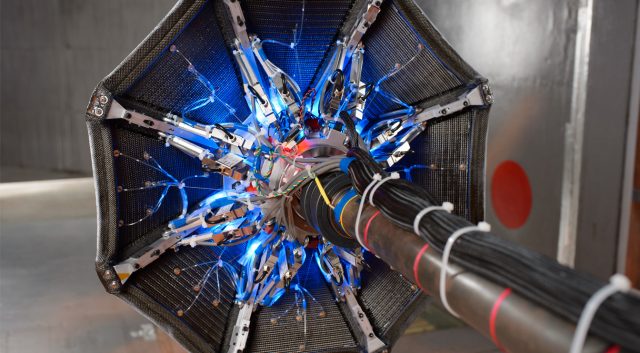NASA’s Adaptable Deployable Entry Placement Technology (ADEPT) is a foldable carbon fabric device that opens to make an umbrella-like heat shield.
The technology to reach another planet or moon is only worth so much if you can’t land on it. Every landing has its own challenges, but celestial bodies with an atmosphere are particularly vexing. For decades, the heat shields that protect spacecraft during atmospheric entry have been rigid and heavy, but NASA just tested a flexible “umbrella-like” heat shield that could make deep space missions more practical.
The flexible heat shield is known as the Adaptable Deployable Entry and Placement Technology (ADEPT), and it was developed at NASA’s Ames Research Center in California. NASA‘s goal is to make heat shields larger while also reducing weight — it’s an area of spacecraft design long overdue for a change.
Spacecraft are moving at fantastic speeds when they descend to the surface, and that compresses atmospheric gas. The compression causes pressure shock, leading to intense heating in front of the spacecraft as high as 5,400 degrees Fahrenheit (3,000 Celsius). Even a thin atmosphere like the one on Mars can cause significant heat buildup. Current spacecraft use aeroshells to keep the payload cool as it enters an atmosphere. Aeroshells are usually made of thick phenolic plastic and ablates (peels away) under intense heat to protect the spacecraft. The plastic isn’t flexible and weighs quite a lot. Thus, heat shields can’t be larger than the diameter of the rocket that launched them.
ADEPT could change all that. It’s composed of layers of 3D woven carbon fabric stretched over articulating ribs and struts. Rather than ablating, ADEPT re-radiates absorbed heat with very high efficiency to keep the payload cool. Because it’s flexible, the shield can fold up to fit inside a rocket, and then deploy to cover a much larger surface area. ADEPT could help larger spacecraft slow down and avoid heat damage during atmospheric entry.
The test flight on September 12th involved a quick 15-minute sub-orbital flight. The rocket lifted the prototype to an altitude of 60 miles (technically in space) and released it. ADEPT traveled as fast as Mach 3 (2,300 mph), which is slower than it would be moving when entering the atmosphere from space. However, this test was primarily concerned with assessing the engineering and aerodynamics.
With the first test flight in the books, NASA says the next step for ADEPT is re-entering the Earth’s atmosphere at orbital speeds in excess of 17,000 mph (27,000 kph). The agency has yet to set a date for that test.



















































